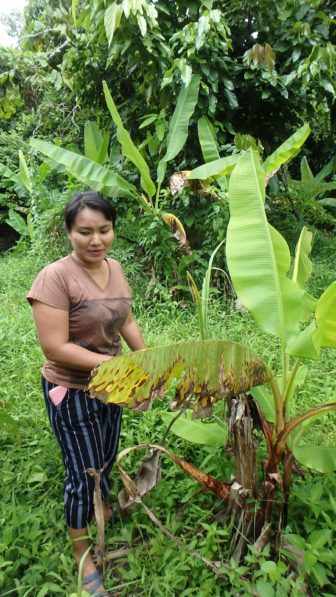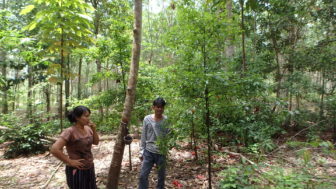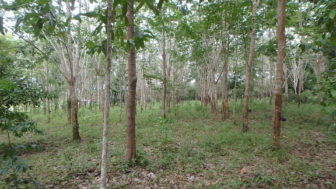Autor: Ronnie Cummins | Publicado: Octubre, 2017
Pregunta Uno: ¿Qué es la Iniciativa “Cuatro por 1000: Suelos por la Seguridad Alimentaria y Clima” lanzada por el gobierno francés en la Cumbre Climática de París en diciembre de 2015?
Respuesta: “Cuatro por 1000: Suelos por la Seguridad Alimentaria y Clima” es un plan global y acuerdo para revertir el calentamiento global, la degradación del suelo, el deterioro de la salud pública y la pobreza rural al aumentar prácticas regenerativas de uso de suelo, agricultura y alimentación. La agricultura regenerativa y la restauración de ecosistemas a gran escala puede preservar cualitativamente y mejorar los suelos, pastizales, bosques y humedales; mientras se reduce y reabsorbe, a través de la fotosíntesis mejorada de las plantas, miles de millones de toneladas de carbono sobrante de la atmósfera durante los siguientes 25 años en nuestros suelos y biomasa. En términos más simples, 4/1000 hace un llamado a la comunidad global para bajar lo más que se pueda de CO2 de la atmósfera (y dejar de emitir otros gases de efecto invernadero) como actualmente lo estamos haciendo.
Pregunta Dos: ¿Cuántos países y regiones del mundo han firmado la iniciativa 4/1000?
Respuesta: Aproximadamente 40 países y regiones del mundo ya han firmado la iniciativa 4/1000, junto con cientos de organizaciones de base de la sociedad civil. Los proponentes de 4/1000 esperan que la mayoría de las naciones, regiones y ciudades firmarán la iniciativa antes de que ésta década termine, para cumplir con sus obligaciones INDC (Contribuciones Previstas y Determinadas a Nivel Nacional, por sus siglas en inglés) bajo el Acuerdo Climático de París. Algunos de los países que ya han firmado son: Francia, Alemania, Argentina, Australia, Austria, Bulgaria, Costa Rica, Costa de Marfil, Dinamarca, Finlandia, Hungría, Irlanda, Japón, Marruecos, México, Nueva Zelanda, Polonia, Portugal y Uruguay.
Pregunta Tres: ¿La iniciativa 4/1000 propone que podemos revertir el calentamiento global y alimentar al mundo sin reducir de manera drástica las emisiones de combustible fósil?
Respuesta: No. Los proponentes de la iniciativa 4/1000 creen que necesitamos lograr tanto cero emisiones de combustibles fósiles como la absorción máxima de CO2 excedente de la atmósfera durante los siguientes 25 años.
Pregunta Cuatro: ¿Por qué esta iniciativa global se llama “Iniciativa Cuatro por 1000?
Respuesta: 4/1000 se refiere al porcentaje promedio de aumento del carbono en el suelo que necesitamos conseguir cada año durante los siguientes 25 años para estabilizar al clima y revertir el calentamiento global. Un aumento de 4/1000 en la cantidad de carbono almacenado en los suelos del mundo (actualmente 1.5-2.5 trillones de toneladas, dependiendo de a qué profundidad se mida el carbono) durante los siguientes 25 años, combinado con cero emisiones de combustibles fósiles, nos permitirá reabsorber suficiente carbono adicional (150-250 mil millones de toneladas, o 6 a 10 mil millones de toneladas al año) en nuestros suelos y bosques para regresar a la atmósfera al nivel pre-industrial (280 ppm de CO2) que necesitamos para estabilizar al clima, aumentar la fertilidad del suelo, mejorar la salud pública, asegurar la soberanía alimentaria, reducir el conflicto mundial y revertir el cambio climático.
Pregunta Cinco: ¿Es realmente posible alcanzar la meta de absorción de 4/1000 de carbono al reabsorber 6-10 mil millones de toneladas de carbono al año, y continuar haciendo esto durante los siguientes 25 años?
Respuesta: Sí, es posible con prácticas agrícolas, alimenticias, ganaderas y de uso de tierra (incluyendo la silvicultura) regenerativas a nivel global, reabsorber 6-10 mil millones de toneladas de carbono al año. Los 22 mil millones de acres de tierra agrícola, pastizales y bosques de la Tierra – aún en su actual estado actual degradado – ya están reabsorbiendo una red de 1.5 mil millones de toneladas de carbono anualmente; mientras que millones de agricultores y ganaderos orgánicos o en transición, a través del uso de mejores prácticas, ya están reabsorbiendo mucho más de 4/1000 por ciento adicional de carbono de suelo cada año, algunos casi 600 veces esta cantidad.
Pregunta Seis: ¿Cuál es el rol de los consumidores, agricultores y otros sectores al cambiar a un sistema regenerativo de alimentos, ganadería y uso de tierra?
Respuesta: Los alimentos, agricultura y uso de tierra regenerativos requerirán de una transformación radical en la consciencia y hábitos de compra entre una masa crítica de 3-4 mil millones de consumidores de alimentos y fibra en el Norte y el Sur global. Los consumidores globales deben dejar de gastar trillones de dólares en alimentos químicos, OGM, y provenientes de una agricultura industrial con uso intensivo de energía; carne, lácteos y pollos de granjas industriales; alimentos altamente procesados y empaquetados; y deben eliminar el desperdicio de alimentos.
Revertir el cambio climático y alimentar al mundo también requerirá de una transformación en las prácticas de producción liderada por una masa crítica de los 500 millones de agricultores familiares, 200 millones de pastores y 50 millones de grandes agricultores existentes en el mundo. Los métodos de la agricultura regenerativa incluyen: manejo holístico y pastoreo de ganado planeado rotacionalmente; labranza cero; evitar químicos y OGMs; uso de cultivos de cobertura; agro-reforestación; uso de composta, estiércol y biocarbono; y uso de plantas y perennes de raíces más profundas.
Comunidades forestales y pesqueras, propietarios de hogares, paisajistas y agricultores urbanos también juegan un papel importante. Existen aproximadamente mil millones de productores de alimentos y agricultores urbanos en áreas urbanas.
Pregunta Siete: ¿Los alimentos y la ganadería regenerativa son lo mismo que la agricultura orgánica, agroecológica o el pastoreo rotativo?
Respuesta: No. La mayoría de los practicantes de métodos orgánicos, agroecológicos y de pastoreo rotacional, certificados o no, pueden ser descritos como “potencialmente Regenerativos”, ya sea que una minoría de estos ya están en “transición a lo Regenerativo.” Existen un número de términos usados para describir prácticas agrícolas y ganaderas ecológicas incluyendo agroecología, agroreforestación, permacultura, biodinámica, manejo holístico o pastoreo, agricultura de conservación, orgánico y otros. Aunque todos estos sistemas agrícolas apoyan prácticas de conservación de suelo en cierto grado, la comida y ganado verdaderamente Regenerativos pone énfasis en maximizar la salud del suelo, la absorción de carbono y la biodiversidad como su foco central.
Pregunta Ocho: ¿Cuáles son las mayores fuerzas detrás del calentamiento global e inestabilidad climática? ¿Qué rol juegan la agricultura industrial, la ganadería industrial, las semillas OGM, el procesamiento de alimentos y su empaquetado, el desperdicio de alimentos y el consumismo en la emisión de gases de efecto invernadero y la degradación de la habilidad del suelo y bosques para reabsorber carbono y mejorar la biodiversidad?
Respuesta: Si miramos de cerca al proceso completo (generalmente llamado la “huella de carbono”) de la alimentación, ganadería y uso de tierra global, nuestro sistema actual de alimentación y fibra químicamente y OGM intensivo, industrial, globalizado, desperdiciador, y altamente procesado produce un alarmante 44-57% de todas las emisiones de gases de efecto invernadero, incluyendo CO2, metano y óxido nitroso. https://www.grain.org/article/entries/5100-la-soberania-alimentaria-5-pasos-para-enfriar-el-planeta-y-alimentar-a-su-gente.
De esta cifra de 44-57%, la mayoría de las emisiones provienen de los 50 millones de granjeros y grandes granjas industriales con uso intensivo de químicos y OGMs, que controlan 75% de la tierra agrícola y producen 30% del alimento del mundo. Estos números contrastan ampliamente con las 500 millones de granjas de agricultores familiares y 200 millones de pequeños pastores que cultivan y pastorean animales en 25% de su tierra, y que a su vez producen el 70% del alimento del mundo.
En términos de categorías de alimentos y ganadería las emisiones de gas de efecto invernadero de la cifra de 44-57% se reparte de la siguiente manera:
- uso directo de petróleo y gas en agricultura: 11-15%
- deforestación 10-15%
- transporte 5-6%
- procesamiento y empacado 8-10%
- congelado y venta por menudeo 2-4%
- desperdicio 3-4%
Nunca llegaremos a cero emisiones de combustible fósil/gases de efecto invernadero (GEI), mucho menos a la capacidad de reabsorber una masa crítica de exceso de CO2 atmosférico, sin una transformación fundamental y completa de nuestro sistema alimenticio, agrícola y de uso de suelo completo.
Pregunta Nueve: ¿Cuál es la participación en el mercado actual de la alimentación y agricultura regenerativa contra la degenerativa?
Respuesta: Los consumidores globales que viven más allá del nivel de subsistencia mínimo (aproximadamente 50% de la población mundial), a diferencia de los aproximadamente tres mil millones o más que viven en el nivel de subsistencia, gastan actualmente $7.55 trillones de dólares en comida, gran parte de la cual es producida por las 50 millones de granjas grandes del mundo, que practican ganadería y agricultura degenerativa, en lugar de regenerativa.
Claro está que gran parte de los 700 millones de agricultores y pastores de subsistencia también usan químicos, pastorean a sus animales de manera inadecuada, debilitan la fertilidad del suelo, y destruyen humedales y bosques bajo las presiones de la pobreza y falta de acceso a buena tierra, asistencia técnica, financiamiento, mercados y otros recursos.
75% de todos los alimentos que se venden hoy en el Norte Global, son alimentos procesados, con bajo valor nutricional; mientras que casi la mitad de los alimentos producidos en total son ya sea desperdiciados o se sobreconsumen. Los costos ocultos de nuestro sistema de alimentación degenerativo y de agricultura son impactantes, con un estimado de $4.8 trillones en gastos anuales por daños sociales, de salud y ambientales. (ETC Group, ¿Quién alimentará al mundo? 2017)
Hay muy poca producción de alimentos y fibra hoy que pueda ser genuinamente descrita como 100% regenerativa. En términos de menos degenerativa o potencialmente en “transición a Regenerativa,” la comida orgánica certificada globalmente (o no certificada), alimentada a base de pastoreo y alimentos producidos sustentablemente es considerada menor a un trillón de dólares.
Pregunta Diez: ¿Qué importa más en términos de redirigir la alimentación, el pastoreo y el uso de suelos hacia un camino regenerativo: las políticas públicas o la demanda del mercado?
Respuesta: Ambas son esenciales. Hasta ahora, la demanda de mercado y la supervivencia de la agricultura tradicional y las prácticas de crianza de ganado están impulsando la regeneración y el potencial regenerativo de los alimentos, la agricultura y el uso de suelo. El apoyo hacia la producción orgánica y de pastoreo ha aumentado en varias regiones, especialmente en los Estados Unidos y Europa. En algunos países por ejemplo, la mayor parte de la producción de carne es 100 % de pastoreo (Australia y Uruguay, por ejemplo) y por lo tanto es al menos semi-regenerativa.
Desafortunadamente, la mayoría de los países del mundo da más de 600 mil millones de dólares anualmente a la agricultura industrial, los OGMs, las exportaciones globalizadas y las granjas industriales. Solamente un pequeño porcentaje de los subsidios gubernamentales se destina a lo orgánico, de libre pastoreo o lo que podría llamarse, prácticas de transición a lo regenerativo.
A largo plazo necesitaremos tanto la presión de los mercados como también miles de millones de dólares destinados a políticas y financiamiento público para que la gran mayoría de los 750 millones establecimientos agrícolas se muevan en una dirección regenerativa, de la misma manera necesitaremos llevar a cabo proyectos de restauración de ecosistemas, reforestación y preservación de humedales.
Pregunta Once: ¿Cómo pueden los consumidores conscientes y la actual minoría de campesinos regenerativos, agricultores y aquellos que hacen un apropiado uso de suelo lograr que se les una más gente?
Respuesta: Para lograr una transición que vaya del consumo y las prácticas de producción degenerativas hacia regenerativas, será necesario educar a los consumidores, agricultores y los gestores de suelo sobre los beneficios ambientales, sociales, económicos y climáticos de la alimentación, agricultura y uso de suelos regenerativos, combinados con asistencia técnica gratuita, capacitación e incentivos fiscales.
En cada zona, región y país deberán identificase las mejores prácticas y practicantes, y deberá dárselas a conocer. También necesitaremos establecer proyectos pilotos regenerativos, brindar educación de campesino a campesino y aumentar el financiamiento y las reformas de políticas públicas.
Pregunta Doce: ¿Cuántos campesinos, pastores, rancheros y gestores de suelo están llevando a cabo prácticas regenerativas o potencialmente regenerativas en lugar de degenerativas?
Respuesta: Existen 2.5 millones de granjas orgánicas certificadas en 120 países que pueden ser tipificadas como potencialmente regenerativas o en transición hacia lo regenerativo. Existen también unas 10-20 más que están cultivando de manera orgánica (aunque no están certificadas) y y proveen para sus familias y los mercados locales.
La organización de las Naciones Unidas para la Alimentación y la Agricultura estimó que 25-50 millones de las 750 millones de las granjas están usando prácticas tradicionales y sustentables y podrían hacer la transición hacia prácticas regenerativas si contaran con la asistencia técnica y financiera suficiente.
Pregunta Trece: ¿Qué porcentaje de consumidores y agricultores deberán adoptar prácticas de consumo y producción regenerativas si queremos alcanzar las metas de la Iniciativa 4 por 1000?
Respuesta: Centrándonos en los 25-50 millones de agricultores “potencialmente regenerativos”, debemos lograr que estos productores sustentables transiten hacia un modo completamente o casi completamente regenerativo durante los próximos cinco años (2017-2022). A la vez, debemos lograr que otros 50 millones pasen de prácticas químicas o degenerativas a prácticas de transición o regenerativas (orgánicas, fueren o no certificadas, de pastoreo, agroecológicas, de permacultura). Luego tenemos que duplicar este ritmo entre 2022 y 2027, de manera que en 10 años tengamos 100 millones de productores regenerativas y otros 100 millones de productores en transición hacia lo regenerativo.
Para 2032 necesitamos acelerar este proceso para que la mayoría de los agricultores, pastores y gestores de suelo (aproximadamente unas 400 millones de granjas y ranchos) realicen prácticas regenerativas o casi regenerativas. Durante este mismo período, entre 2017 y 2032, deberemos lograr una rápida transición hacia energías 100 % renovables y cambiar la forma en que piensan y compran los consumidores.
Todo esto implica una gran presión de mercado sobre las corporaciones de alimentos y fibras, para que sus cadenas de suministro pasen de degenerativas a regenerativas e implica también cambios fundamentales en las políticas gubernamentales adoptadas por ciudades, regiones, estados, agencias internacionales e instituciones de financiamiento.
Pregunta Catorce: ¿Cuáles son los principales obstáculos para alcanzar la iniciativa 4 por 1000?
Respuesta: Los principales obstáculos para lograr las metas de la iniciativa 4/1000 son:
- Falta de conocimiento público no solo de la Iniciativa 4/1000, sino también de las perspectivas de uso de suelo, agricultura regenerativa y captura de carbono en general.
- Los gigantescos subsidios impositivos de la mayoría de los países controlados por corporaciones que usan prácticas degenerativas de alimentos, agricultura, y uso de suelo.
- La falta de unidad y cooperación entre los movimientos ambientales, climáticos, de paz, democráticos, de justicia social, de salud natural y de alimentación tanto dentro como fuera de las fronteras de los países.
- La falta de financiamiento y de políticas públicas que apoyen iniciativas regenerativas tales como 4/1000.
Todos estos impulsores de la degeneración están relacionados con el control corporativo de la economía nacional e internacional y la corrupción intrínseca en los procesos políticos.
Pregunta quince: ¿Cómo puedo convencer a mi organización, ciudad, país, o provincia para que sea parte de la Iniciativa Cuatro por 1000?
Respuesta: Necesitamos crear grupos estratégicos y coaliciones a nivel organización, local, municipal, estatal/provincial y nacional. En las mismas deben participar los movimientos agrícolas, ambientales, por la paz, la democracia, la salud natural, la alimentación, y la justicia. Sumado a esto, debemos accionar los movimientos de base y la educación para que los gobiernos a nivel nación, estado/provincia, municipal y local suscriban la Iniciativa 4/1000 y apoyen para que haya un cambio significativo en las dinámicas de presión de mercado y las políticas públicas.
Pregunta Diéciseis: ¿Dónde puedo encontrar más información sobre la alimentación, agricultura y uso de suelos regenerativos, para que pueda convertirme en un activista e imppulsor de la iniciativa?
Respuesta: Visite el sitio de Internet de Regeneration International. www.RegenerationInternational.org
Revise los recursos en línea de Bio4climate.org.
https://bio4climate.org/resources/compendium/
Pregunta Diecisiete: ¿Cómo puedo saber más acerca de la iniciativa 4/1000?
Respuesta: Visite el sitio de Internet 4/1000 de la iniciativa. https://4p1000.org/
Lea esta breve guía de políticas. https://www.ase.tufts.edu/gdae/Pubs/climate/ClimatePolicyBrief4.pd



